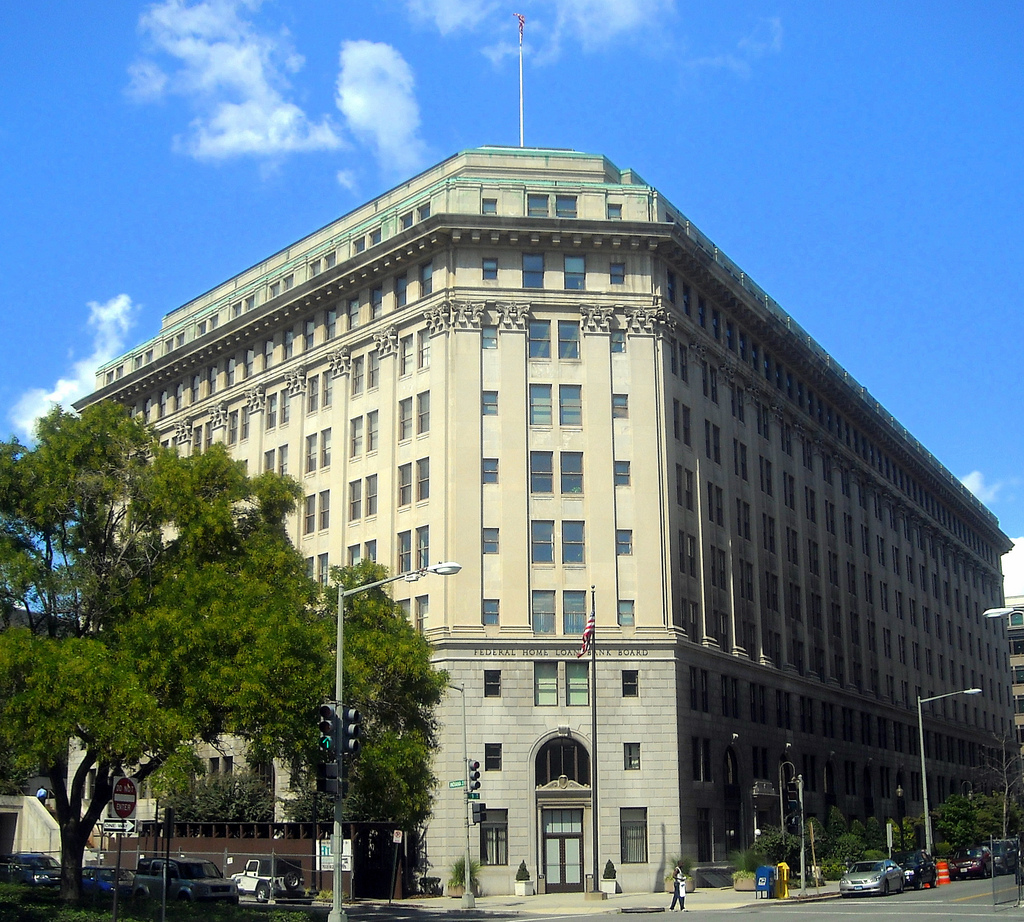The Next Bank Bailout
Regional institutions crucial to providing loans for mortgage lending around the country, are showing the same warning signs as Fannie Maw and Freddie Mac last year.
Jul 31, 202045.8K Shares619.5K Views
Federal Home Loan Bank Board building, Washington, DC (Flickr: NCinDC)
With financial stocks sliding as fears grow that more major banks may fail, it’s easy to overlook the problems at the Federal Home Loan Banks,a group of 12 regional institutions that play a crucial role in providing banks around the country with money for mortgage lending.
But that would be a mistake. The banks served as a lender of last resort as the credit crunch tightened, propping up other banks that now have gone under. The crisis now facing them exemplifies the regulatory and other weaknesses in the financial system that have led to the worsening banking crisis, analysts say – sloppy accounting, a lack of transparency, lax oversight, and the trend toward “scheming” a way out of the credit crunch. Wall Street is nervous because it can’t determine the true extent of problems at the banks. And, once again, taxpayers may end up picking up the tab.
Illustration by: Matt Mahurin
“They’ve got a real problem on their hands,” said James Bianco, president of Bianco Researchin Chicago, a leading analyst and market commentator, in reference to the Federal Home Loan Bank system. “And it’s helping to drag down larger banks as well.”
The difficulties of the once-obscure government-backed but privately-run banks came into the spotlight earlier this month, when Moody’s released a reportsaying that in a worst-case scenario, eight of the 12 banks could run low on cash because they own billions of dollars of toxic mortgage securities that are now worthless. The banks are a major source of low-cost lending to 8,000 institutions ranging from small community banks to commercial banks to credit unions. Federal Home Loan banks in both Seattle and Pittsburgh in particular warnedrecently that their capital is running low. Moody’s concluded the government may have to step in with funding to keep the banks going.
Michael Youngblood, founderof Five Bridges Capital, an asset management company in Bethesda, Md., described the banks as “a victim of circumstance that has affected financial institutions doing mortgage lending in the United States.” And Bert Ely, an industry analyst in Alexandria, Va. said the banks’ problems also are tied to accounting rules that make their losses seem more severe than they are. “Their investments have backfired on them,” Ely said. “But I think they’re going to be all right. If they go under, we’ve got even worse problems in the economy than we thought.”
But on Wall Street, that’s exactly what already-jittery investors fear.
Some think the Atlanta FHLB could be taken over by the Federal Reserve, that the San Francisco bank could be merged with other banks, and that the New York bank has lost a significant amount of money, Bianco said. He doesn’t buy the argument that accounting problems are to blame: “That’s the same thing they used to say about Fannie Mae and Freddie Mac,” he said.
The government tookcontrol of the two mortgage giants in September, after the agencies suffered losses from risky mortgage-basked securities.
The Federal Home Loan Banks have been plagued for years by “sloppy” accounting, Bianco said, and investors are wary of assurancesthat the worst-case scenario described by Moody’s is unlikely.
“They could be sitting on big losses,” Bianco said. “We don’t know how many bad loans they have, and their accounting is so bad investors don’t have any confidence in their numbers.”
The banks’ regulator until recently was the Federal Housing Finance Board,created in the wake of the savings and loan scandal of the late 1980s. Asking why the banks were permitted to operate for years with poor accounting practices, Bianco said, is “like asking why the SEC never cracked down on Bernie Madoff,” who ran a Ponzi scheme for years that ultimately cost investors $50 billion.
The same regulators of the savings and loans that collapsed were hired on with the Federal Housing Finance Board, which meant real reform never happened.
“When you fail in Washington,” Bianco said, “you get a promotion.”
In July, the government merged the Federal Housing Finance Board into the Federal Housing Finance Agency,which now also oversees Fannie and Freddie and has expanded regulatory powers.
The problems of the Depression-era banks stem from the sharp expansion of their role in the credit crisis, beginning in 2007. The government used the banks as a “defacto discount window” to prop up the financial system, as other sources of credit began to dry up, Bianco said. Banks that eventually failed or were sold, from Countrywide to Washington Mutual to Citigroup, quickly borrowed a record $163 billion from the Federal Home Loan Banks to stay afloat. “The government was using the Federal Home Loan Banks as a way to bail out the banking system early on,” he said.
The moves raised some questions at the time. Sen. Charles Schumer (D-N.Y.) wrotea letter in November 2007 to the Federal Housing Finance Board, complaining about $51.5 billion in loans from the Atlanta Federal Home Loan Bank to Countrywide. Schumer said he found the figures “alarming.” Peter Wallison, an American Enterprise Institute scholar who studies the financial system, also expressedconcern that the government was taking unnecessary risks in making the banks the lender of last resort.
But not only did the lending continue – it grew even more. In February of last year, Barry Ritholtz of The Big Picture calledthe banks’ expanded role a covert bailout and an “ongoing and expensive venture into irresponsible lending and speculation – all at the taxpayer’s expense.”
Youngblood, of Five Bridges, said the Federal Home Loan Banks had little choice. The Office of Thrift Supervision, Countrywide’s regulator, had declared the bank sound, giving the banks little criteria to turn down loans. Besides, the alternative might have been making the credit crunch even worse, he said. “It was a calculated risk,” he explained.
But Washington Mutual eventually collapsed, in the biggest bank failure in U.S. history. Countrywide, once the nation’s largest subprime lender, was bought by Bank of America in January, and its shares have fallen by 64 percent since then. Citigroup, awash in bad loans, said it lost $19 billion last year. Investors are worried about Wells Fargo since its acquisition of Wachovia and its toxic mortgage securities. Nouriel Roubini, the New York University business professor who predicted the credit crisis, this week calledthe U.S. banking system “essentially insolvent.”
The Federal Home Loan Banks are chartered by the government but operate as a privately run cooperative. As they did with Fannie and Freddie, investors assume the federal government would bail the system out if it got in trouble. The banks receive top ratings from the ratings agencies and are able to borrow money more cheaply due to the implicit government backing.
The banks’ problems illustrate how the government may have promised more than it can deliver in keeping failed or troubled institutions afloat, Bianco said.
“Everybody thinks we can scheme our way out of this,” Bianco said. “There’s no scheming our way out of it. There’s not enough credit to go around.”
With the real possibility of government guarantees being called on “all in one day,” he said, “the whole system is coming apart.”
Not everyone is as pessimistic as Bianco. Alex Pollock, a banking expert at the conservative think tank, American Enterprise Institute, said the doesn’t think the Federal Home Loan Banks are in peril of going under. “It doesn’t really look to me like an insolvency issue,” Pollock said. Neither Youngblood nor Ely also thinks the banks will fail, but acknowledged they may need some financial help from the government.
Regardless of whether they survive, the crisis has opened a window into longtime, overlooked weaknesses in Federal Home Loan Bank system and its oversight. Ely said the in the 1980s, the Federal Home Loans Banks were known as “flubs,” for their poor risk controls. Bianco described them as “having had losses for years.”
Yet as the credit crisis intensified, the government chose to make them the lender of last resort to major banks overwhelmed with toxic mortgages. And that leaves taxpayers facing the possibility of yet another bailout.

Rhyley Carney
Reviewer
Latest Articles
Popular Articles

